Visit The Sanssouci Park On Your Next Germany Trip In 2026
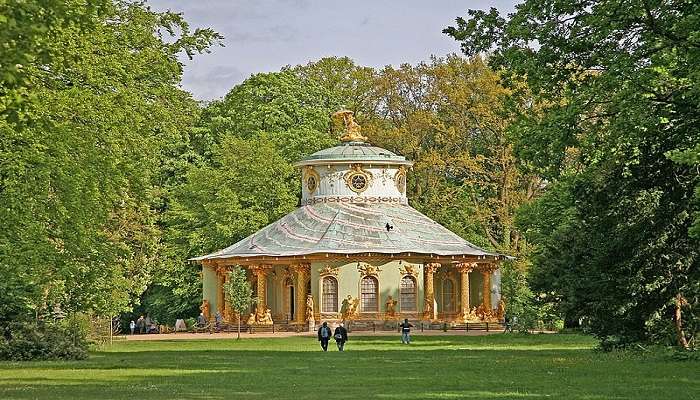
Sanssouci Park in Potsdam, Germany, is a UNESCO World Heritage site, an outstanding example of Rococo architecture and landscape design, built by Frederick the Great in the 18th century. Lying over an area of 290 hectares, the park houses the famous Sanssouci Palace, also known as the From the vineyards that are built on the terraces to the magnificent fountains and the secret caves, every corner of Sanssouci Park is a masterpiece that depicts the vision of art and the ambition of the royal family. Get ready to be enthralled by this real-life history representing Prussia’s best.
About Sanssouci Park

Sanssouci Park is one of the most beautiful parks in the world. It is situated in Potsdam, Germany, and encompasses the Sanssouci Palace. Frederick the Great constructed the park in the mid-18th century. It contains a Baroque flower garden with lawns, flower beds, hedges, and trees. It also has 3,000 fruit trees and greenhouses containing oranges, melons, peaches, and bananas.
The park has statues of the two goddesses, Flora and Pomona, depicting a flower, fruit, and vegetable garden. In 1990, Sanssouci Park, along with Sanssouci Palace and other palaces and parks nearby, was included in the UNESCO World Heritage List for its architectural ensemble and as an example of the European garden of the 18th and first half of the 19th century.
Also Read: Berlin Street Food
History of Sanssouci Park

Initially built in the mid-18th century by Frederick the Great, King of Prussia, the park was intended to be a place of relaxation from the stately formality of the Berlin court. Sanssouci translates to ‘without worry’, and this was the King’s idea of a house of leisure. It has a Baroque flower garden with well-manicured lawns, flower beds, hedges and trees. It also contains different fruit trees and greenhouses where exotic plants such as oranges, melons, peaches and bananas are grown. Sanssouci Park is not an ordinary Baroque garden; it is a beautiful garden with an added purpose, which was a principle that Frederick used in his previous works.
The park grew over the years to encompass several essential structures, including the New Palace, the Picture Gallery and the New Chambers. These structures comprise a single architectural ensemble connecting the park’s avenues and rondels. In 1990, Sanssouci Park and other nearby palaces and gardens were included in the list of UNESCO World Heritage Sites for the best example of the European landscape design of the 18th and 19th centuries.
Things To Do At Sanssouci Park
Sanssouci Park at Potsdam is one of the most beautiful parks in the world, and it has been included in the UNESCO list of heritage sites for tourists. It is a place where one can be alone with nature and discover many things, making it a perfect destination for tourists interested in nature and history.
1. Sanssouci Palace – Schloss Sanssouci
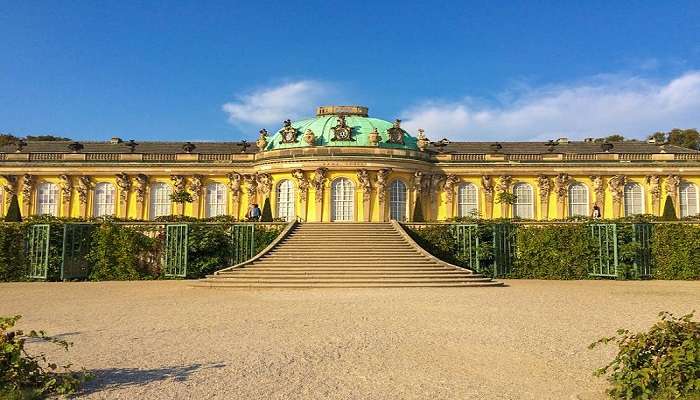
Rococo architecture is well illustrated in Sanssouci Palace, which was constructed by Frederick the Great. It was his summer residence, and he is famous for the beautiful gardens and the vineyard terraces. The interior of the palace is no less magnificent. The rooms are vibrant, and the decoration is lovely.
Opening Hours
- April to October: Tuesday – Sunday: 9:00 AM – 5:30 PM
- November to March: Tuesday – Sunday: 9:00 AM – 4:30 PM
- Closed on Mondays
Admission Fees: €14 / reduced €10
Related Post: Munich Lakes
2. The New Palace
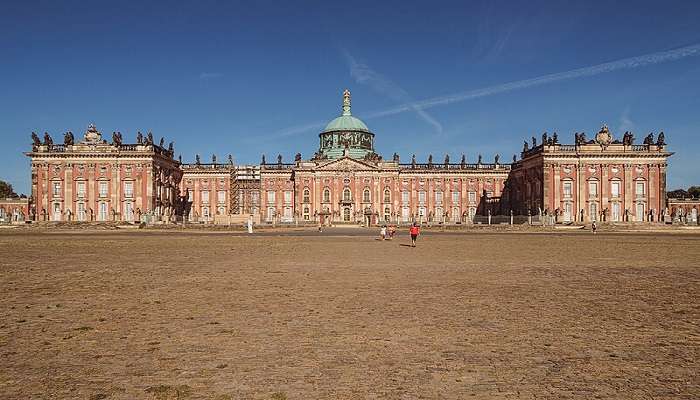
Sanssouci is in the northern part of Potsdam, while the New Palace is in the western part of Sanssouci Park. The former is a large Baroque palace constructed by Frederick the Great to signify the power of Prussia. It has elaborate rooms, grand dining halls, and a magnificent theatre.
Opening Hours:
- April to October: Wednesday – Sunday: 10:00 AM – 5:30 PM
- November to March: Wednesday – Sunday: 10:00 AM – 4:30 PM
- Closed on Mondays and Tuesdays
Admission Fees: €12 / reduced €8
3. The Orangery Palace
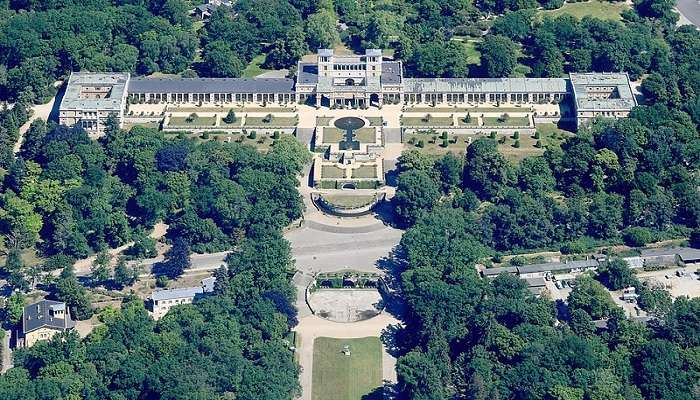
The Orangery Palace, inspired by Italian Renaissance architecture, is one of the largest palaces in Sanssouci Park. It houses the Raphael Hall, which contains over 50 copies of Raphael’s paintings and offers stunning views from its towers.
Opening Hours:
- April to October: Tuesday – Sunday: 10:00 AM – 5:30 PM
- November to March: Tuesday – Sunday: 10:00 AM – 4:30 PM
- Closed on Mondays
Admission Fees: €8 / reduced €6
Related Post: Munich Lakes
4. The New Chambers
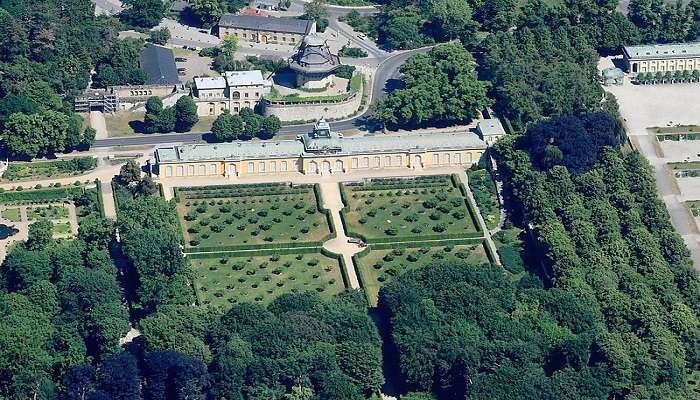
The New Chambers, originally built as an orangery, were later converted into guest apartments by Frederick the Great. The interiors are richly decorated with Rococo art and feature beautiful galleries and salons.
Opening Hours:
- April to October: Tuesday – Sunday: 10:00 AM – 5:30 PM
- November to March: Tuesday – Sunday: 10:00 AM – 4:30 PM
- Closed on Mondays
Admission Fees: €6 / reduced €4
5. The Picture Gallery

The Picture Gallery, located near Sanssouci Palace, is one of the oldest museum buildings in Germany. It houses an impressive collection of European paintings, including works by Caravaggio, Rubens, and Van Dyck.
Opening Hours
- April to October: Tuesday – Sunday: 10:00 AM – 5:30 PM
- November to March: Tuesday – Sunday: 10:00 AM – 4:30 PM
- Closed on Mondays
Admission Fees: €6 / reduced €4
Related Post: Autumn In Munich
6. The Historic Windmill

The Historic Windmill, located near Sanssouci Palace, is a reconstructed Dutch-style windmill. From its viewing platform, it offers a glimpse into the milling process and provides panoramic views of Sanssouci Park.
Opening Hours
- April to October: Tuesday – Sunday: 10:00 AM – 5:30 PM
- November to March: Tuesday – Sunday: 10:00 AM – 4:30 PM
- Closed on Mondays
Admission Fees: €4 / reduced €3
7. The Chinese House

The Chinese House is a charming garden pavilion in Sanssouci Park, designed in the Chinoiserie style. It features ornate decorations, gilded statues, and a beautiful interior that reflects the 18th-century fascination with Chinese art.
Opening Hours
- April to October: Tuesday – Sunday: 10:00 AM – 5:30 PM
- November to March: Tuesday – Sunday: 10:00 AM – 4:30 PM
- Closed on Mondays
Admission Fees: €4 / reduced €3
Related Post: Munich Castles
8. Charlottenhof Manor
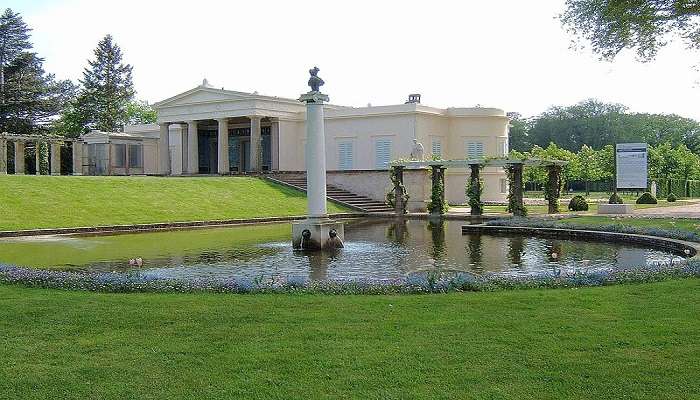
Charlottenhof Manor, designed by Karl Friedrich Schinkel, is a neoclassical palace that served as Crown Prince Frederick William’s summer residence. The palace is known for its elegant interiors and beautiful gardens.
Opening Hours:
- April to October: Tuesday – Sunday: 10:00 AM – 5:30 PM
- November to March: Tuesday – Sunday: 10:00 AM – 4:30 PM
- Closed on Mondays
Admission Fees: €6 / reduced €4
9. The Roman Baths
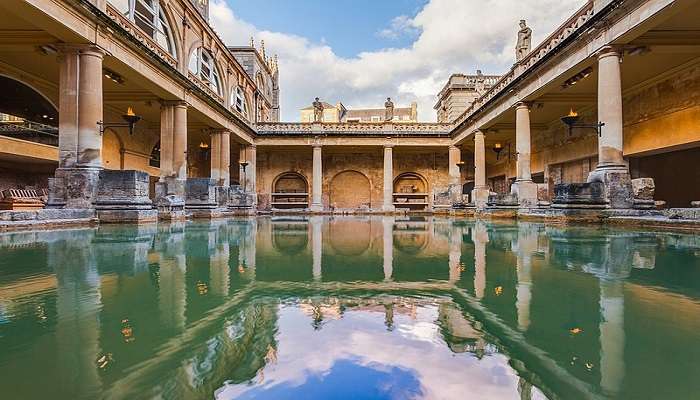
The Roman Baths, inspired by ancient Roman architecture, are a complex of pavilions in Sanssouci Park. These pavilions include a bathhouse, a tea house, and a gardener’s residence surrounded by beautiful scenery. The best time to visit Sanssouci Park in Potsdam is from May to September when the weather is good for touring the park, its beautiful gardens, and the Rococo palaces.
Opening Hours
- April to October: Tuesday – Sunday: 10:00 AM – 5:30 PM
- November to March: Tuesday – Sunday: 10:00 AM – 4:30 PM
- Closed on Mondays
Admission Fees: €4 / reduced €3
Related Post: Summer In Berlin
10. The Church of Peace

The Church of Peace is a basilica-style church at the extreme right of Sanssouci Park. Frederick William IV constructed it. It has beautiful mosaics, a water pond, and a lovely garden that creates a serene environment. The building has frescoes and marble columns, and it is a very suitable location for meditation and contemplation of the architectural design.
Opening Hours
- April to October: Tuesday – Sunday: 10:00 AM – 5:30 PM
- November to March: Tuesday – Sunday: 10:00 AM – 4:30 PM
- Closed on Mondays
Admission Fees: Free
11. Belvedere on Klausberg
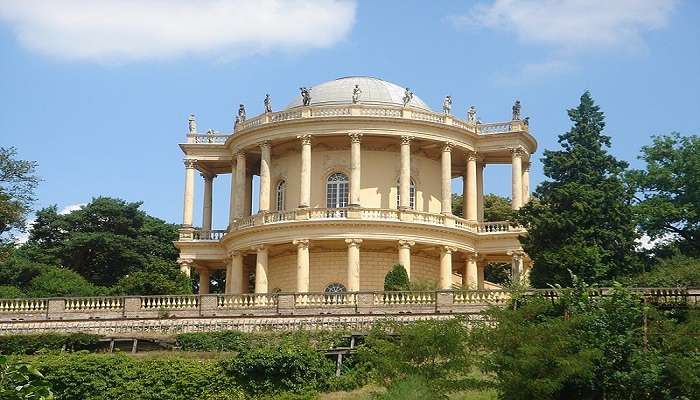
The Belvedere on Klausberg is a small, ornate, two-storeyed pavilion that provides a beautiful view of Sanssouci Park and the nearby landscape. Frederick the Great constructed it as a leisure and recreational facility to enjoy the scenery.
Opening Hours
- April to October: Tuesday – Sunday: 10:00 AM – 5:30 PM
- November to March: Tuesday – Sunday: 10:00 AM – 4:30 PM
- Closed on Mondays
Admission Fees: €4 / reduced €3
Related Post: Summer In Germany
12. Norman Tower on the Ruinenberg
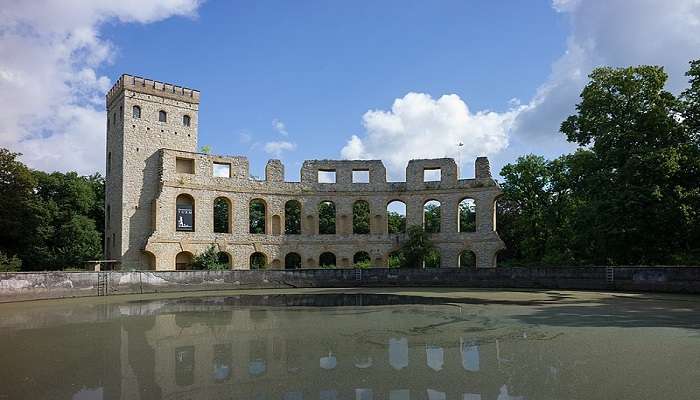
The Norman Tower is a medieval-style tower on Ruinenberg Hill. It provides visitors with a view of Sanssouci Park and Potsdam. Frederick the Great constructed it as part of his park landscaping.
Opening Hours:
- April to October: Tuesday – Sunday: 10:00 AM – 5:30 PM
- November to March: Tuesday – Sunday: 10:00 AM – 4:30 PM
- Closed on Mondays
Admission Fees: €4 / reduced €3
Opening Hours and Entrance Fees

Sanssouci Park is open from 8 a.m. to sunset, so visitors can visit at any time of the year. The park is free of charge, so people of all classes can appreciate the natural scenery and historical structures.
However, visitors are welcome to contribute €2 to the cost of managing and conserving the park. This is a small way of ensuring the park is well maintained so that future generations can appreciate the cultures and natural resources.
Also Read: Munich In January
Best Time to Visit
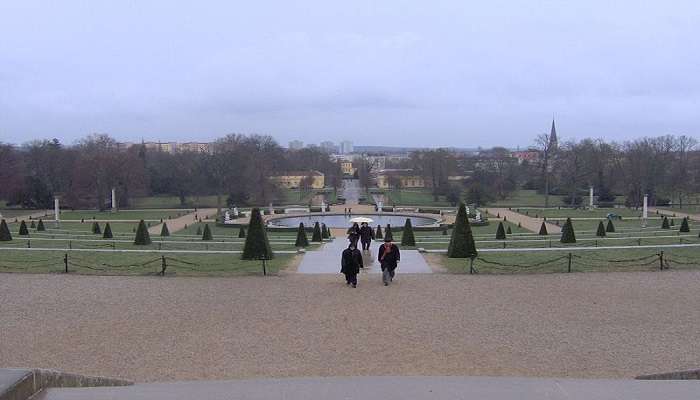 \
\The best time to visit Sanssouci Park in Potsdam is during the summer period, from May to September, when one can tour the park, the beautiful gardens, and the Rococo palaces.
June is lovely because the gardens are blooming, and the flowers are in full bloom with bright colours. During this period, the visitors can also enjoy the beautiful looks of the cherry blossoms in spring and the autumn colours, which are a natural beauty to the park.
How To Reach Sanssouci Park?
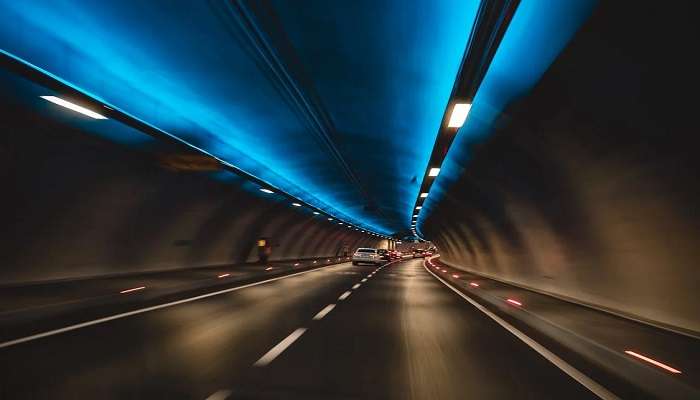
Sanssouci Park is one of the oldest parks and palaces, and it is famous for its stunning gardens and marvellous constructions. Below is a detailed guide on how to reach Sanssouci Park:
By Air
The nearest international airport to Sanssouci Park is Berlin Brandenburg Airport, Berlin-Brandenburg Willy-Brandt Airport or BER. After arriving at the airport, you can travel to Sanssouci Park by train or taxi.
By Rail
From Berlin Central Station or Berlin Alexanderplatz, take the S7 train to the Potsdam terminus. Change to bus 614 or 650 and get off at Bornstädter Straße. From there, it’s a 5-minute walk to the palace. From Berlin Potsdamer Platz, take the S1 train and get off at Berlin Wannsee. Take the S7 train instead and alight at the Potsdam terminus. Then, one has to take the 614 or 650 bus to Bornstädter Straße. Sanssouci Palace is located a 5-minute walk away from the tour’s starting point.
By Public Transport
If you are coming from Berlin Central Station or Berlin Alexanderplatz, take the S7 train to Potsdam. Take bus no.614 or 650 and alight at Bornstädter Straße. The palace is about 5 minutes walk from here. From Berlin Potsdamer Platz, take the S1 train and alight at the Berlin Wannsee station. Take the S7 train and alight at the Potsdam terminal station. One can take the bus number 614 or 650 to Bornstädter Straße. Continue walking for about 5 minutes, and you will get to the palace.
By Car
From Berlin, take the A115 out of town to the Potsdam-Babelsberg interchange. Continue in the direction of the Potsdam city centre. Follow the signs and drive to the parking lot P1 next to the Historic Windmill.
You May Also Like To Read: Hindu Temples In Germany
Sanssouci Park is characterised by its Prussian style and royal aspirations. The beautiful palaces, well-maintained gardens, and history of the place give tourists a feel of ancient royalty. Whether walking through the vineyard terraces, looking at the elaborated Rococo style of the buildings, or just enjoying the silence, Sanssouci Park will be a great experience. Do you want to travel? This is a great opportunity, so take it. Book your trip to Europe today, and we will help you plan your trip to make Sanssouci Park a part of your tour. Learn about the history and architecture of Potsdam’s crown jewel and make the memories of a lifetime. Your royal adventure awaits!
For our editorial codes of conduct and copyright disclaimer, please click here.
Cover Image Credit: W. Bulach for Wikimedia Commons
Frequently Asked Questions About Sanssouci Park
Is Sanssouci Park free?
Yes, entry to Sanssouci Park is free. However, visitors can make a voluntary contribution to help support the maintenance and preservation of the gardens.
What is Sanssouci Palace famous for?
Sanssouci Palace is renowned for its Rococo architecture and its role as the summer residence of Frederick the Great, King of Prussia. It is often celebrated for its elegance and historical importance compared to Versailles.
Why to visit Sanssouci?
Sanssouci Palace and its park, both UNESCO World Heritage sites, offer a fascinating glimpse into Prussian history and feature stunning architecture. It’s a must-visit for those interested in history and architecture.
How much time do you spend at Sanssouci Palace?
Plan to spend at least half a day at Sanssouci Palace and its park. While the palace tour takes about an hour, the extensive gardens and other attractions in the park deserve additional time.
Can you go inside Sanssouci Palace?
Yes, visitors can go inside Sanssouci Palace. It’s open to the public, but booking tickets in advance is recommended, especially during peak tourist season, to ensure entry.
People Also Read:
Nehru Park Vuda Park Neendoor Park

With a passion for travelling, and carving beautiful stories of stunning locations I chose my profession as a content writer. The unique blend of creativity and strategy ensures that each narrative takes readers on a journey to their desired destination. With distinct locations and unique vibes, I strive to deliver captivating content that speaks to the hearts of readers.











